book on the Campo Marzio
1995.01.03
... start the book with a chapter on the long (longest actually) axis going from the Vatican Hill to the Tiber River.
After the chapter of the long axis, there will be a chapter on the triumphant processional route. This will engage the long axis and then cross the Tiber River and go through the Piazza Navona part of contemporary Rome, and end up at a gate in the Roman wall.
the long axis
1995.01.03
...the axis going from the Nympheun on the Vatican Hill, straight down through the Area Martis and through the Hadrian/Domitiae complex and ending with a nympheum on the banks of the Tiber, between Hadrian's tomb and Augustus's tomb, is in fact the longest, straight planned axis/route within the entire Ichnographia. I believe the great length is significant, and I also believe Piranesi began his work on the Ichnographia in the area immediately under the large dedication block.
the long axis - Area Martis
1995.01.03
In approximately the center of the long axis is the Area Martis.
outline - long[est] axis
1995.01.07
--the triumphant way as the start of the long axis.
--its extremes and the sexual connotations displayed by the buildings at the center of the long axis (Templum Martis) and the buildings at the two extremes of the axis (the two nympheums and the little intercourse building on the west bank of the Tiber).
the Horti Neroniani
--the basic orthogonal layout and simple architectural composition.
--the relationship of the site the present Basilica of Saint Peters and the curious coincidence of a large basilica-shaped porticus in Piranesi's plan.
--Piranesi's seeming late inclusion of the circus/stadium and the whole issue of Saint Peter's death and burial on this exact site. The circus and a group of sepulchers are both in the Ichnographia.
--the first sign of what I call Piranesi's metabolic approach to Roman architecture as seen in the wings of the Porticus Neronianae and also perhaps in the permutations of various monumental tombs and towers spread regularly throughout the garden.
Moving to the other extreme of the axis, we find a triumphal arch which mirrors the arch at the entrance of the Area Martis. These two arches, both on the long axis, are also disposed with respect to the cross axis of Hadrian's tomb. This begins the analysis of the Hadrian complex.
--Hadrian's tomb being one of the very few extant building within the Ichnographia.
--the discovery and true placement of the circus Hadriani (see Nolli map) and how the tomb and the circus probably spurned the enormity of the entire Hadrian complex and the second longest axis in the Ichnographia. Also included is the continuation of an orthogonal layout and the extreme exercise of symmetry.
--the two porticus Hadriani on both sides of the Tiber.
--the interesting correlation of the long row of sepulchers in the Hardian complex to the three sided sepulchers in the Horti Neroniani.
the Horti Agrippinae
--the introduction of the non-orthagonal approach.
outline - long[est] axis
1995.01.07
a. the Templum and Area Martis.
b. the longest axis.
c. the Horti Neroniani.
d. the dual Hadrian/Domitia complex (duality and symmetry).
e. the Horti Agrippinea.
f. the rest of the buildings west of the Tiber.
new insights - key to the language of plans
1996.07.15
This note concerns my new insight into Piranesi's Campo Marzio. Eessentially I think I hit upon a substantial key concerning the language of the plans within the Campo Marzio. In retrospect, I think it was an understanding of Piranesi's plan language that I was interested in finding out from the very beginning--at least since I learned CAD.
The key to the language of plan forms starts with the long 'spiritual' axis of Mars and the tiny temple/shrine to the union of Mars and Rhea Silvia. I will not here go into the whole story of the long axis except to say that the Mars/Rhea Silvia shrine at the very end of the axis is the very basis of all the Piranesi plan forms. The plan of the shrine itself depicts, in simple planimetric form, the union of the male sex organ with the female sex organ. The plan is plain and simple, and where it not for its small size, would also be perceived as vulgar and blunt. Yet there is an essential beauty in its fertile simplicity--the notion of elementary plan forms is enhanced a thousand fold by the symbolism of outside vs. inside--gives it the power to spawn every other plan formation delineated.
The power and significance of the small shrine plan comes to the fore after an analysis of the second significant axis of the Campo Marzio--the Equiria. This axis represents the war/military aspect of Mars, and when compared with the long axis running through the altar to Mars, the Equiria, the race course, can be clearly considered the mundane axis (as opposed to the spiritual or sacred axis). The military character of the axis is quickly reinforced by the military offices and the military parade grounds that lie to the northern end of the Equiria. The fact that the Equiria is a horse race course also reinforces the mundane/military character of the axis, and this mundane aspect is most clearly manifest with the dirt road reality of the axis itself. (There may be the opportunity to call out a sacred vs. profane contrast between the two axes.)
Seeing how the first axis ends in sex, I was curious to see if the Equiria axis also ends in sex. While there is no building plan that explicitly depicts the co-joining of sexual organs, the north end of the axis has a pair of simple buildings--Vivaria Fulvii and Cochlearum Hirpini--made up of very few contiguous elements. I think this type of plan is the next step in the hierarchy after the sex temple. It is almost as if the sex temple starts something that quickly multiplies and mutates in the process. These two plans next to each other demonstrate the high order of symbolism in the first.
From the second order of plan, the next step up in the hierarchy is best exemplified by the sw Gymnasium on the Tiber and the Villa Publicus where the contiguous elements are still few yet numerously repeated, however there is a substantial addition of articulation in the individual contiguous pieces, especially in the carving out of space in the form of niches and thus heightening the issues of outside/inside, solid/void, figure/ground. This third type of plan formation is much more strongly related to the sex temple, yet the lesson of the second type of plan, the gemmation of a few parts, is a vital step in the evolutionary development of the plans. I wonder if I could here call it an embryonic development of the plan configuration. I also wonder if the second order of plan formation is to be considered profane vs. the sacred union of sex?
life and death axes
1996.09.01
...an analysis and comparison between the long sacred axis and the Hadrian tomb axis. The main point being the contrast between the nympheums at the ends of the long axis and the tombs situated at the ends of the Hadrian axis. In simple terms the first axis celebrates life (nympheums) while the second (cross) axis celebrates death (tombs). This all still goes with the notion of these axes being of a scared nature, and, furthermore, it is significant that the life and death axes cross each other at right angles.
| |
Exhibit 1 text
1997.03.20
Life and Death within Piranesi's Ichnographia of the Campo Marzio
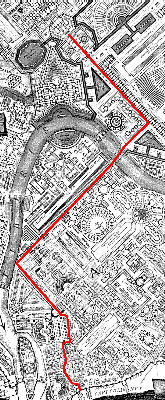
With a consistent dashed line, Piranesi demarcates the Triumphal Way through the Campo Marzio. The processional route begins, with historical and archeological accuracy, at the Templum Jani, which is situated at the bottom of the Ichnographia. The victor's march weaves through Rome's "theater district"--past small baths, shops, and brothels--and then continues on a long straight course towards the Tiber. Across the river, the procession turns behind the Sepulchrum Hadriani and approaches its end at the Templum Martis, the god of War and for whom the Campo Marzio is named. As the ultimate destination of the Triumphal Way, the Templum Martis is clearly among the most sacred, if not the most sacred, of places within the Campo Marzio, and, therefore, perhaps offers a key that lifts the Campo Marzio's "mask."
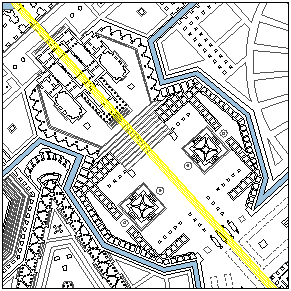
The Templum Martis fittingly promulgates overt manliness. Male genitalia boldly inform the Temple's plan, and the linear projection of the Temple's "endowment" manifests the Campo Marzio's longest straight axis.
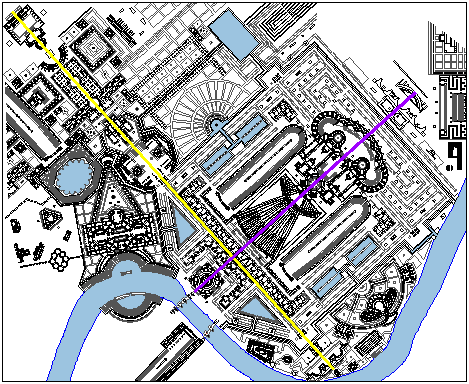
As the axis of Mars spans from the Vatican Hill to the bend in the Tiber, it intersects the Campo Marzio's second longest straight axis, which bisects Hadrian's Tomb and the Bustum Hadriani. The perpendicular crossing of the two axes naturally creates a diametrical opposition. Geometry alone, however, does not represent the depth of their oppositeness.
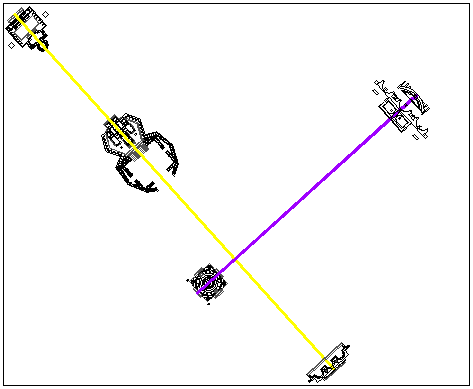
The axis of Mars terminates at either end with a nymphaeum, while the axis through the Bustum Hadriani terminates at either end with an Imperial Tomb. The antithesis of nymphaeums and tombs is self-evident, and, therefore, attests to the axis of Mars representing life and the Bustum axis representing death.
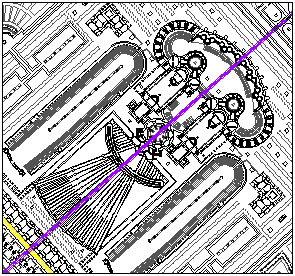
The Bustum Hadriani with its crematoriums and funereal banqueting halls, moreover, is nothing less that a gigantic "machine" to facilitate the passage from this life to the next. Yet, for all its architectural bombast, the Bustum Hadriani can in no way compete with the exalted simplicity of the tiny unnamed structure, which is behind the nymphaeum on the bank of the Tiber and at the very tip of the axis of life.
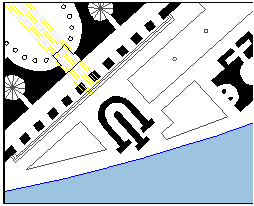
Campo Marzio index
1997.08.05
Beginning the analysis of the Campo Marzio with Mars leads directly to the triumphal way and the long axis, hence the promenade architecturale and the axes of life and death. Then discuss the equirria and the military axis.
|